Hinano Pearl farm - Fakarava - (52)

|
Lucy & I dinghied ashore early to arrange our pearl farm tour. Hinano’s
Gunther agreed that we could go on a tour at 2pm, so I went over to the dive shop to see what Roger had arranged.
At 2pm we all met up, credit cards in hand (BIG mistake!!!!). The drive out to the farm was nice as it gave us a better idea of what the rest of island was like. The pearl farm is built over the water on stilts. Gunther talked us through the whole process. Mantel This is then trimmed and cut up into small squares, these are the grafts.
Gonad
They then pry open the shell, slit open the gonad, insert the graft into the incision and then put the nucleus in, so that the graft and the nucleus are touching. The oyster is then put in a protective netting sleeve and returned to the water. The sleeve protects the oyster from trigger fish and other predators. Within a month the incision has healed and the graft has enveloped the nucleus and the pearl is beginning to grow. After 18 months the graft should have created 1.5 mm of mother of pearl around the nucleus, this meets with the industry standard. The oyster is once again pried open, the gonad is once again cut open, the pearl removed and if it is of sufficient quality a new nucleus, the size of the pearl that had just been removed, is put back in its place. In this way they create larger pearls. This process takes a few seconds.
Geoffry was the technician demonstrating to the process. He had been doing this for 4 and a half years and was extremely adept, moving with the precision of a surgeon. Good oysters can be used for up to 16 years. But the older the oyster, the less likely to get good quality pearls. The waters around Fakarava are not very good for collecting new seed oysters as too many other molluscs take advantage of the collectors, taking up valuable space. So the seed oysters are bought from another island that specialises in collecting. It was a fascinating tour. Then we were taken to the shop, oh dear. Let’s just say that I got a little carried away (not as much as some other yachties who were reputed to have spent in excess of $2000!!) So it was a happy little camper that trotted off to meet Roger after his dive.
We had debated on whether or not he should take the camera with him, we thought better of it, after what we had heard from other divers, telling tales of hanging on for dear life. It was a very disciplined dive. As soon as they hit the water they went down to 5 mts and the dive master did the safety checks there. They then proceeded to descend to 40 mtrs, all the time drifting with the current. Eventually the sea bed rose to meet them and they then grabbed on and moved hand over hand along the bottom, where they waited. Above them were hundreds of different sharks, all around them were hundreds of fish and I forgot to mention that there were also sharks swimming close to them. But they seemed totally disinterested in the divers, having checked them out, they swam off. They then carried on, crawling along the coral like crabs, to the next viewing spot, where there were more sharks and huge Napoleon Wrasse. The next stop was in a gulley, out of the current. There were fish everywhere, Roger reckoned if he had taken the camera, he would have been able to point it at random and get a photo full of fish!!! From there it was an ascent to the safety stop. One of the divers had gone into decompression time, so they all had to do a 16 minute safety stop. But they had been down 48 minutes, so it was a good dive. He enjoyed it so much that we are booked on tomorrows dive at the Southern passage, which is a gentler dive, but with as many sharks. But tomorrow we are taking the camera, so watch this space. |
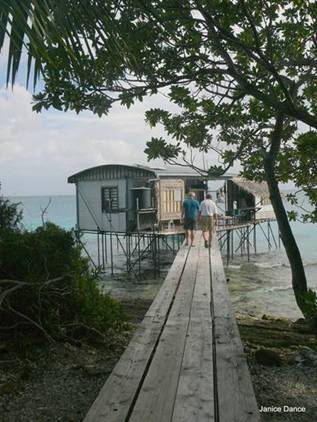
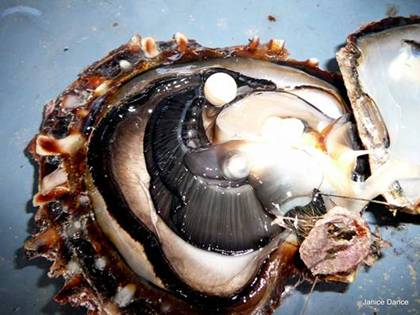 He was planning to do the north passage drift dive,
which we had heard so much about. I was not able to do it, as it is a strong
current and very rough seas, so getting into the boat at the end of the dive
might be a problem, with my knees in the state they are. Still I had the pearl
farm to look forward to.
He was planning to do the north passage drift dive,
which we had heard so much about. I was not able to do it, as it is a strong
current and very rough seas, so getting into the boat at the end of the dive
might be a problem, with my knees in the state they are. Still I had the pearl
farm to look forward to.

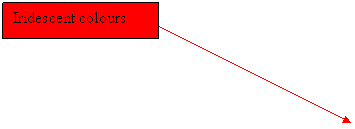

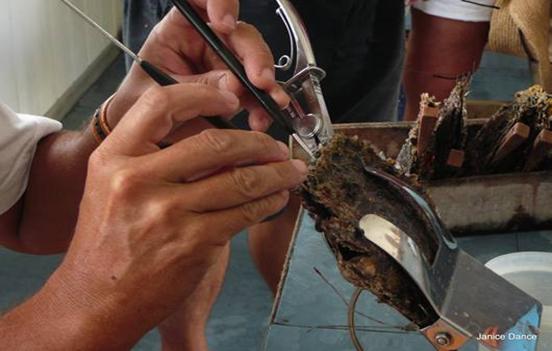 Then next stage is to find a recipient oyster. Now here
is the interesting part. Polynesian pearls are black or grey, Japanese are only
white, Filippino are pink, each hybrid of oyster only producing a particular
colour, it is not random. However, when they are selecting the recipient oyster,
they pry it open, just enough to see the mother of pearl inside and not damage
the muscle. What they are looking for is iridescence. If the mother of pearl has
produced it in the shell, then there is a good chance of getting good
iridescence in the pearl.
Then next stage is to find a recipient oyster. Now here
is the interesting part. Polynesian pearls are black or grey, Japanese are only
white, Filippino are pink, each hybrid of oyster only producing a particular
colour, it is not random. However, when they are selecting the recipient oyster,
they pry it open, just enough to see the mother of pearl inside and not damage
the muscle. What they are looking for is iridescence. If the mother of pearl has
produced it in the shell, then there is a good chance of getting good
iridescence in the pearl.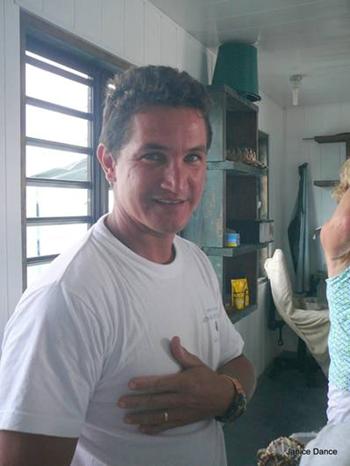
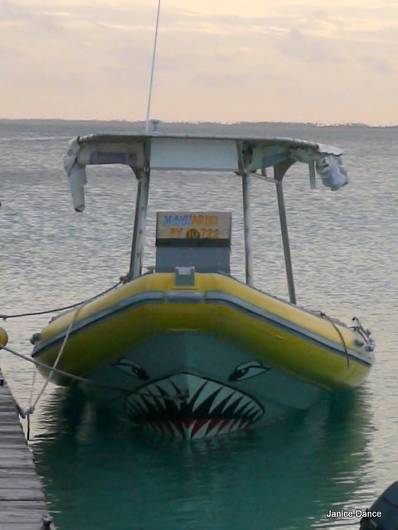 When I asked Roger how the dive was, he simply said
‘mind blowing’!!! I will do it again!!
When I asked Roger how the dive was, he simply said
‘mind blowing’!!! I will do it again!!